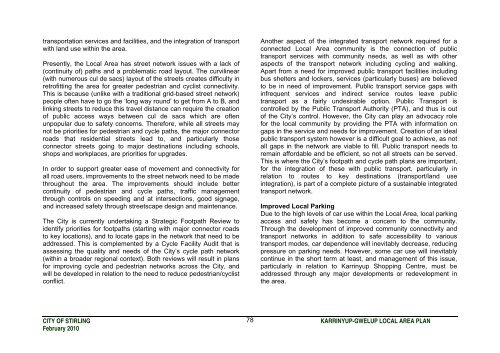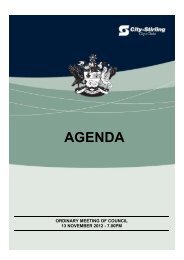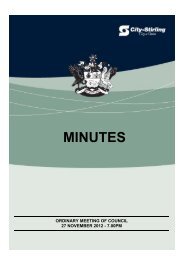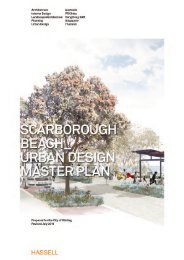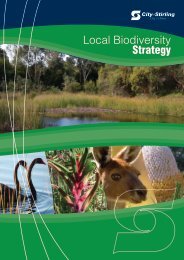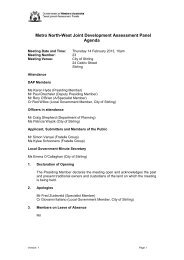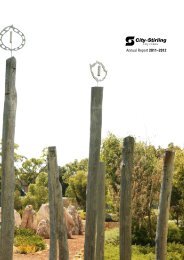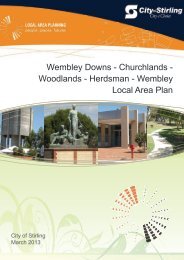KARRINYUP / GWELUP Local Area Plan - City of Stirling
KARRINYUP / GWELUP Local Area Plan - City of Stirling
KARRINYUP / GWELUP Local Area Plan - City of Stirling
Create successful ePaper yourself
Turn your PDF publications into a flip-book with our unique Google optimized e-Paper software.
transportation services and facilities, and the integration <strong>of</strong> transport<br />
with land use within the area.<br />
Presently, the <strong>Local</strong> <strong>Area</strong> has street network issues with a lack <strong>of</strong><br />
(continuity <strong>of</strong>) paths and a problematic road layout. The curvilinear<br />
(with numerous cul de sacs) layout <strong>of</strong> the streets creates difficulty in<br />
retr<strong>of</strong>itting the area for greater pedestrian and cyclist connectivity.<br />
This is because (unlike with a traditional grid-based street network)<br />
people <strong>of</strong>ten have to go the ‘long way round’ to get from A to B, and<br />
linking streets to reduce this travel distance can require the creation<br />
<strong>of</strong> public access ways between cul de sacs which are <strong>of</strong>ten<br />
unpopular due to safety concerns. Therefore, while all streets may<br />
not be priorities for pedestrian and cycle paths, the major connector<br />
roads that residential streets lead to, and particularly those<br />
connector streets going to major destinations including schools,<br />
shops and workplaces, are priorities for upgrades.<br />
In order to support greater ease <strong>of</strong> movement and connectivity for<br />
all road users, improvements to the street network need to be made<br />
throughout the area. The improvements should include better<br />
continuity <strong>of</strong> pedestrian and cycle paths, traffic management<br />
through controls on speeding and at intersections, good signage,<br />
and increased safety through streetscape design and maintenance.<br />
The <strong>City</strong> is currently undertaking a Strategic Footpath Review to<br />
identify priorities for footpaths (starting with major connector roads<br />
to key locations), and to locate gaps in the network that need to be<br />
addressed. This is complemented by a Cycle Facility Audit that is<br />
assessing the quality and needs <strong>of</strong> the <strong>City</strong>’s cycle path network<br />
(within a broader regional context). Both reviews will result in plans<br />
for improving cycle and pedestrian networks across the <strong>City</strong>, and<br />
will be developed in relation to the need to reduce pedestrian/cyclist<br />
conflict.<br />
Another aspect <strong>of</strong> the integrated transport network required for a<br />
connected <strong>Local</strong> <strong>Area</strong> community is the connection <strong>of</strong> public<br />
transport services with community needs, as well as with other<br />
aspects <strong>of</strong> the transport network including cycling and walking.<br />
Apart from a need for improved public transport facilities including<br />
bus shelters and lockers, services (particularly buses) are believed<br />
to be in need <strong>of</strong> improvement. Public transport service gaps with<br />
infrequent services and indirect service routes leave public<br />
transport as a fairly undesirable option. Public Transport is<br />
controlled by the Public Transport Authority (PTA), and thus is out<br />
<strong>of</strong> the <strong>City</strong>’s control. However, the <strong>City</strong> can play an advocacy role<br />
for the local community by providing the PTA with information on<br />
gaps in the service and needs for improvement. Creation <strong>of</strong> an ideal<br />
public transport system however is a difficult goal to achieve, as not<br />
all gaps in the network are viable to fill. Public transport needs to<br />
remain affordable and be efficient, so not all streets can be served.<br />
This is where the <strong>City</strong>’s footpath and cycle path plans are important,<br />
for the integration <strong>of</strong> these with public transport, particularly in<br />
relation to routes to key destinations (transport/land use<br />
integration), is part <strong>of</strong> a complete picture <strong>of</strong> a sustainable integrated<br />
transport network.<br />
Improved <strong>Local</strong> Parking<br />
Due to the high levels <strong>of</strong> car use within the <strong>Local</strong> <strong>Area</strong>, local parking<br />
access and safety has become a concern to the community.<br />
Through the development <strong>of</strong> improved community connectivity and<br />
transport networks in addition to safe accessibility to various<br />
transport modes, car dependence will inevitably decrease, reducing<br />
pressure on parking needs. However, some car use will inevitably<br />
continue in the short term at least, and management <strong>of</strong> this issue,<br />
particularly in relation to Karrinyup Shopping Centre, must be<br />
addressed through any major developments or redevelopment in<br />
the area.<br />
CITY OF STIRLING 78<br />
<strong>KARRINYUP</strong>-<strong>GWELUP</strong> LOCAL AREA PLAN<br />
February 2010


